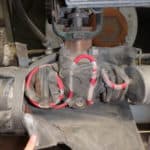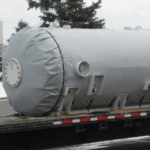Wastewater treatment is a critical process that protects both our environment and public health. It involves the removal of contaminants from municipal and industrial wastewater, allowing the treated water to flow safely back into the environment. A vital part of this treatment process is the heating of sewage sludge, a byproduct of both primary and biological treatment stages.
However, wastewater sludge heating has challenges because it is thick and dense. The nature of sludge and slurries makes it difficult to heat effectively and safely. Adding to the complexities is the exothermic process nature of anaerobic digestion. It creates heat, which means that temperature control must be precise. We’ll explore the precise temperatures required and solutions for the various heating challenges.
The Nature of Sludge and Slurries
Sludge and slurries are mixtures in wastewater treatment processes. Sludge refers to the solid particles that settle at the bottom of tanks or clarifiers during the treatment of wastewater. It is typically a dense, semi-solid material that contains a combination of organic and inorganic matter, such as bacteria, chemicals, and other impurities.
Slurries are less dense mixtures of liquid and solid particles. Both sludge and slurries can be hard to handle and process efficiently. Understanding their nature enables effective implementation of heating strategies in wastewater treatment systems.
The Importance of Wastewater Sludge Heating
The wastewater treatment process requires heating of the sludge for several reasons:
- Maintaining the appropriate temperature is critical for optimizing the biological activity within the sludge. Temperature influences the growth of microorganisms responsible for breaking down organic matter, ensuring optimal treatment and reducing the presence of harmful pathogens. Inconsistent or inadequate heating leads to slow bacterial digestion.
- Proper sludge heating helps to reduce the viscosity, making it easier to pump and process. It improves the efficiency of subsequent treatment processes, such as dewatering and digestion.
- Efficient sludge heating can also prevent the formation of crusts or solid accumulation in tanks and pipes. Proper consistency reduces maintenance costs and prolongs the lifespan of equipment.
Overall, effective sludge heating is crucial for ensuring the successful treatment of wastewater and maintaining the overall efficiency of the treatment plant.
Safety Considerations in Sludge Heating
Safety is a top priority in any industrial process, and sludge heating in wastewater treatment is no exception.
One of the most significant risks comes from the potential for spontaneous self-heating in the incoming sludge. The increased temperatures can pose a threat to equipment and operators. In addition, the high water content of the sludge can lead to steam generation, which can also be hazardous.
Other safety considerations include the potential for chemical reactions within the sludge, mainly if it contains hazardous or reactive chemicals that can lead to potentially harmful gaseous emissions or even spontaneous combustion. Operators must have a clear understanding of the heating process and the equipment being used to ensure the safety of the entire operation.
Another safety consideration is the use of chemicals in wastewater treatment, such as Caustic Soda, a.k.a. Sodium Hydroxide (NaOH), used to adjust the water’s pH level. Heating caustic soda is essential to keep it above 70°F (21°C) to prevent freezing and to maintain viscosity.
Solutions for Sludge and Slurries Heating
In this section, we will explore some innovative solutions for heating sludge and slurries:
Custom Pipe and Tank Heaters:
Custom pipe heaters provide precise temperature control and can accommodate the specific characteristics of the sludge, including:
- Maintaining consistency, composition, and flow rate.
- Provides precise temperature control for heating sludge in pipes and tanks.
- Prevents sludge from cooling and solidifying in the pipes.
- It can be customized to fit specific pipe sizes and configurations.
- Ensure the efficient operation of the anaerobic digestion process.
Custom pipe and tank heaters have the added benefit of being able to handle the high viscosity of sludge and slurries.
The Role of Heat Trace Systems
Heat trace involves the use of heating cables along the length of the pipes carrying the sludge. These cables provide a constant source of heat, maintaining the sludge at the optimal temperature for anaerobic digestion. Heat trace technology offers several advantages.
- Uses electric heating cables to maintain a consistent temperature in pipes.
- Prevents sludge from cooling and clogging the pipes.
- It can be installed on both metal and non-metal pipes.
- Offers flexibility in terms of length and configuration.
Custom heating solutions provide uniform heat distribution, preventing cold spots that can lead to clogging.
Circulation Heaters for Wastewater Treatment Plants
Circulation heaters offer another solution for sludge and slurry heating. These heaters work by circulating the sludge through a series of heat exchangers, gradually raising its temperature. This method allows for a high degree of temperature control.
- Circulates hot water or thermal oil through a heat exchanger to heat sludge.
- Provides efficient and uniform heating.
- Reduces energy costs by using a closed-loop system.
- Suitable for handling high-viscosity fluids.
Circulation heaters are highly efficient. They reuse heat from the outgoing sludge to preheat the incoming sludge. Reclaiming heat reduces energy costs and contributes to the sustainability of the wastewater treatment process.
Progressive Cavity Pumps
Standard pumps often struggle with sludge due to its high viscosity, leading to frequent clogs and maintenance issues. The solution is the progressive cavity pump. Sometimes called a screw pump or positive displacement pump, they can handle dense sludge and slurries. They also offer features such as adjustable flow rates, which can be beneficial in managing the heating process. Features of progressive cavity pumps include:
- Uses one helix metal rotor that turns inside of a double-helix molded rubber stator.
- Provides both pumping and heating in a single unit.
- Handles high-viscosity and abrasive fluids.
- Offers precise control over the flow rate and temperature.
It is best to install grinders upstream of the pump to chew up debris to keep the pumps operating efficiently and reduce messy and hazardous pump clean-outs.
Another solution to managing sludge and slurry temperature is with a heating blanket.
Advantages of Powerblanket for Sludge Heating
Powerblanket offers a heating blanket that wraps around tanks or pipes to provide consistent and uniform heat. It offers precise temperature control, allowing for efficient and effective heating of sludge without contacting it. Powerblanket heating blankets are portable so that they can heat a wide range of applications throughout the wastewater treatment plant. Click the link to get a custom quote for your specific requirements.
Frequently Asked Questions about Sludge and Slurries Heating in Wastewater Treatment
To gain a better understanding of wastewater treatment, we’ve added some common questions.
-
How do you heat sludge?
Sludge can be heated using various methods such as steam, hot water, or direct heat transfer through custom pipe and tank heaters.
-
Can sewage sludge be used for energy?
Yes, sewage sludge can be used for energy. It can be processed into biogas or incinerated to generate heat and electricity.
-
What happens when sludge is heated?
When sludge is heated, it undergoes several changes. The heat destroys pathogens, evaporates moisture, decomposes organic matter, and the sludge becomes more manageable for further treatment or disposal.
-
What is the heating value of sewage sludge?
The heating value of sewage sludge varies depending on its composition. Thoroughly dried sewage sludge has a calorific value comparable to that of lignite (the lowest-grade coal). The dry substance-based (DS) calorific value of sewage sludge is approximately 11 to 13 MJ/kg DS.
Every wastewater facility requires a custom solution as the amount and types of sludge vary.
The Value of Customized Heating Solutions for Wastewater Sludge Treatment
From custom pipe and tank heaters to circulation heaters, Powerblanket offers a range of options to meet the unique needs of each wastewater treatment plant. These solutions offer precise temperature control, reduced energy costs, and the flexibility to handle varying sludge types and compositions effectively. Furthermore, they prioritize safety, ensuring the safe and efficient processing of sludge.
Ensuring the efficiency of your wastewater treatment process is paramount, especially in colder climates; don’t let suboptimal temperatures hinder your operation’s potential when tailored solutions are within reach. Explore Custom Solutions.
Frequently Asked Questions
How do you know if you have sludge in your heating system?
Signs of sludge in a heating system include radiators not reaching the desired temperature, a leaking or failing boiler pump, and boiler parts being clogged with dirt, which can be resolved by regular maintenance and cleaning.
What is sludge and how is it heated?
Sludge is a semi-solid byproduct of wastewater treatment, heated using methods like custom pipe heaters and circulation heaters to optimize biological activity and facilitate further processing.
What is the heat treatment of sludge?
Heat treatment of sludge involves raising its temperature to 180-200°C for 30-60 minutes, which alters its physical structure, making it easier to process and reducing its resistance.
How do you remove sludge from a heating system?
Sludge can be removed from a heating system through a power flush, which circulates high-pressure water and cleaning chemicals to clear out accumulated debris and improve system efficiency.
Don't let the cold weather stop your business. Powertrace heat trace cable will keep you running smoothly no matter how low the temperatures.




